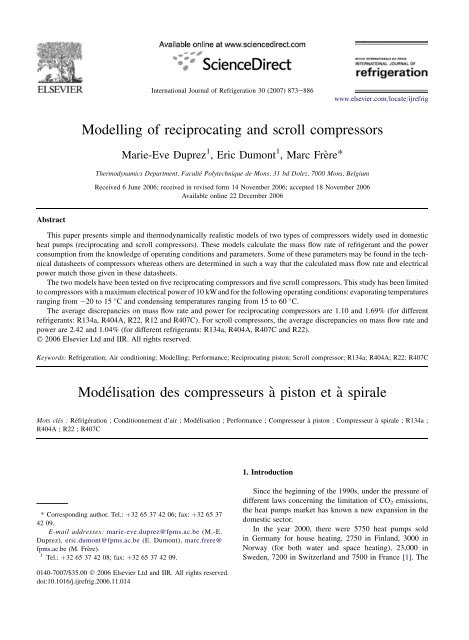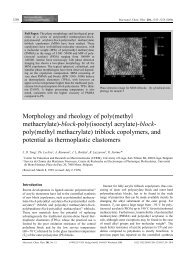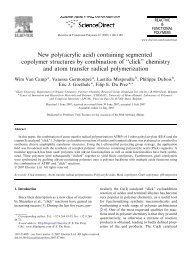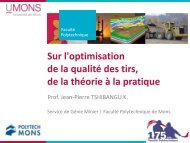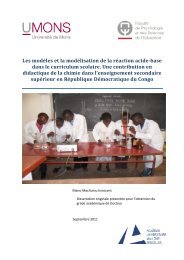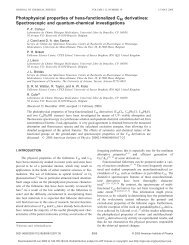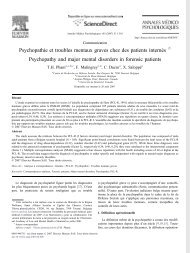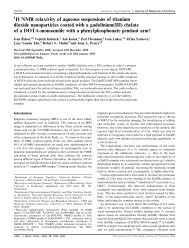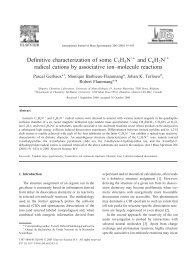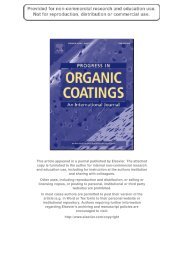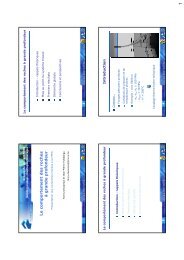Modelling of reciprocating and scroll compressors Modélisation des ...
Modelling of reciprocating and scroll compressors Modélisation des ...
Modelling of reciprocating and scroll compressors Modélisation des ...
Create successful ePaper yourself
Turn your PDF publications into a flip-book with our unique Google optimized e-Paper software.
International Journal <strong>of</strong> Refrigeration 30 (2007) 873e886www.elsevier.com/locate/ijrefrig<strong>Modelling</strong> <strong>of</strong> <strong>reciprocating</strong> <strong>and</strong> <strong>scroll</strong> <strong>compressors</strong>Marie-Eve Duprez 1 , Eric Dumont 1 , Marc Frère*Thermodynamics Department, Faculté Polytechnique de Mons, 31 bd Dolez, 7000 Mons, BelgiumReceived 6 June 2006; received in revised form 14 November 2006; accepted 18 November 2006Available online 22 December 2006AbstractThis paper presents simple <strong>and</strong> thermodynamically realistic models <strong>of</strong> two types <strong>of</strong> <strong>compressors</strong> widely used in domesticheat pumps (<strong>reciprocating</strong> <strong>and</strong> <strong>scroll</strong> <strong>compressors</strong>). These models calculate the mass flow rate <strong>of</strong> refrigerant <strong>and</strong> the powerconsumption from the knowledge <strong>of</strong> operating conditions <strong>and</strong> parameters. Some <strong>of</strong> these parameters may be found in the technicaldatasheets <strong>of</strong> <strong>compressors</strong> whereas others are determined in such a way that the calculated mass flow rate <strong>and</strong> electricalpower match those given in these datasheets.The two models have been tested on five <strong>reciprocating</strong> <strong>compressors</strong> <strong>and</strong> five <strong>scroll</strong> <strong>compressors</strong>. This study has been limitedto <strong>compressors</strong> with a maximum electrical power <strong>of</strong> 10 kW<strong>and</strong> for the following operating conditions: evaporating temperaturesranging from 20 to 15 C <strong>and</strong> condensing temperatures ranging from 15 to 60 C.The average discrepancies on mass flow rate <strong>and</strong> power for <strong>reciprocating</strong> <strong>compressors</strong> are 1.10 <strong>and</strong> 1.69% (for differentrefrigerants: R134a, R404A, R22, R12 <strong>and</strong> R407C). For <strong>scroll</strong> <strong>compressors</strong>, the average discrepancies on mass flow rate <strong>and</strong>power are 2.42 <strong>and</strong> 1.04% (for different refrigerants: R134a, R404A, R407C <strong>and</strong> R22).Ó 2006 Elsevier Ltd <strong>and</strong> IIR. All rights reserved.Keywords: Refrigeration; Air conditioning; <strong>Modelling</strong>; Performance; Reciprocating piston; Scroll compressor; R134a; R404A; R22; R407CModélisation <strong>des</strong> compresseurs à piston et à spiraleMots clés : Réfrigération ; Conditionnement d’air ; Modélisation ; Performance ; Compresseur à piston ; Compresseur à spirale ; R134a ;R404A ; R22 ; R407C1. Introduction* Corresponding author. Tel.: þ32 65 37 42 06; fax: þ32 65 3742 09.E-mail addresses: marie-eve.duprez@fpms.ac.be (M.-E.Duprez), eric.dumont@fpms.ac.be (E. Dumont), marc.frere@fpms.ac.be (M. Frère).1 Tel.: þ32 65 37 42 08; fax: þ32 65 37 42 09.Since the beginning <strong>of</strong> the 1990s, under the pressure <strong>of</strong>different laws concerning the limitation <strong>of</strong> CO 2 emissions,the heat pumps market has known a new expansion in thedomestic sector.In the year 2000, there were 5750 heat pumps soldin Germany for house heating, 2750 in Finl<strong>and</strong>, 3000 inNorway (for both water <strong>and</strong> space heating), 23,000 inSweden, 7200 in Switzerl<strong>and</strong> <strong>and</strong> 7500 in France [1]. The0140-7007/$35.00 Ó 2006 Elsevier Ltd <strong>and</strong> IIR. All rights reserved.doi:10.1016/j.ijrefrig.2006.11.014
874 M.-E. Duprez et al. / International Journal <strong>of</strong> Refrigeration 30 (2007) 873e886Nomenclatured diameter (m)h specific enthalpy (J kg 1 )HP high pressure (Pa)IP intermediate pressure (Pa)LP low pressure (Pa)m mass (kg)N compressor rotation speed (t min 1 )p pressure (Pa)P power (W)p vsat saturated vapour pressure (Pa)q m mass flow rate (kg s 1 )q v volume flow rate (m 3 s 1 )s specific entropy (J kg 1 K 1 )T temperature (K)u specific internal energy (J kg 1 )UA global heat transfer coefficient (W K 1 )v specific volume (m 3 kg 1 )V volume (m 3 )W work (J)Dp suc pressure drop in the suction valve (Pa)DT log log-mean difference temperature (K)superheating (K)DT sup3 ratio between the dead space <strong>and</strong> the sweptvolume (e)h efficiencyr density (kg m 3 )Subscriptsc circulatedcalc calculatedcond condensationconstr constructor datad dead spaceel electricalevap evaporationex exhausti inlet <strong>of</strong> the compressoriso-s isentropicpseudo-iso-spseudo-isentropicmecha mechanicals sweptsuc suctionw fictitious wallaverage growth in terms <strong>of</strong> the number <strong>of</strong> installed heatpumps between 1997 <strong>and</strong> 2000 is about 15% a year.It is important to generalize the use <strong>of</strong> domestic heatpumps in order to decrease the primary energy consumptionin the dwelling sector. For each heat pump project,the type <strong>of</strong> heat pump must be correctly chosen; the <strong>des</strong>ign<strong>and</strong> installation steps must be carried out carefully.For optimization purpose, it would be interesting to disposea calculation tool able to simulate the behaviour <strong>of</strong>the heat pump integrated to the residence so that theenergy consumption could be predicted <strong>and</strong> the <strong>des</strong>ign<strong>of</strong> the heat pump (<strong>and</strong>/or <strong>of</strong> the house) could be adaptedin such a way that the environmental impact is minimized.This simulation tool should remain as simple as possibleso that its use could be wi<strong>des</strong>pread.In this aim <strong>of</strong> modelling such a complete system, it is importantto have the simplest <strong>and</strong> the most accurate models <strong>of</strong>its components. The compressor is one <strong>of</strong> the main part <strong>of</strong>a heat pump as it sets its mass flow rate which governs theheat flows. It is thus the first component <strong>of</strong> the heat pumpto be modelled.The types <strong>of</strong> <strong>compressors</strong> used in domestic heat pumpsare usually the <strong>reciprocating</strong> <strong>and</strong> <strong>scroll</strong> ones. Reciprocating<strong>compressors</strong> are mainly used as far as low thermal power isconcerned (heating water) whereas <strong>scroll</strong> <strong>compressors</strong> arewi<strong>des</strong>pread for space heating.Many different models <strong>of</strong> those two types <strong>of</strong> <strong>compressors</strong>with different degrees <strong>of</strong> complexity are found in theliterature.On the one h<strong>and</strong>, there are models <strong>of</strong> <strong>reciprocating</strong> <strong>compressors</strong>in which the compressor is divided in several volumes(elements such as compression chamber, valves.).Those models require input data very difficult to obtain orknown only by the constructor <strong>and</strong> non-available in the datasheets.The volumes <strong>of</strong> the different elements <strong>and</strong> the effectivearea <strong>of</strong> valves are also required. The transient fluidconservation equations (continuity, momentum <strong>and</strong> energy)are integrated in the whole compressor domain <strong>and</strong> the energybalance for the refrigerant inside the cylinder is computedfor each time step during the operating cycle [2e7].On the other h<strong>and</strong>, models in which thermodynamic assumptionsare made are also found. In those models, dataare not very difficult to obtain: e.g. refrigerant inlet state,outlet refrigerant pressure, clearance volume, motor speed.In Ref. [8] eight input data are sufficient to determinemass flow rate <strong>and</strong> required compressor power. In Refs.[9e11] (model derived from Ref. [8]) the refrigerant massflow rate is affected by the clearance volume re-expansion,by a pressure drop in the suction valve <strong>and</strong> by a heat transferfrom a fictitious isothermal wall. The friction power loss iscomposed <strong>of</strong> a constant contribution <strong>and</strong> another one proportionalto the isentropic power. Ref. [12] presents a simplethermodynamic model for <strong>reciprocating</strong> <strong>compressors</strong> usedin domestic appliances. It required the knowledge <strong>of</strong> five parameterseasy to determine. The main difference betweenthis model <strong>and</strong> the one presented in Ref. [9] is the fact thatthe heat transfer phenomena in the compressor are not consideredin Ref. [12].
M.-E. Duprez et al. / International Journal <strong>of</strong> Refrigeration 30 (2007) 873e886875The same two categories may be defined for <strong>scroll</strong><strong>compressors</strong>.Models [13e16] require the knowledge <strong>of</strong> pocket volumes<strong>and</strong> perimeters for every six degrees <strong>of</strong> rotation, theheight, thickness <strong>and</strong> pitch <strong>of</strong> the <strong>scroll</strong>s that are quitedifficult to obtain. In those models, the whole compressoris divided in several chambers <strong>and</strong> the compressionprocess is simulated for every gas pockets. It requiresthe evaluation <strong>of</strong> areas, volumes, pressures, temperatures<strong>and</strong> specific volumes for every crank angle. Mass <strong>and</strong>energy conservation equations were developed for eachchamber.Model [17] is exclusively thermodynamic <strong>and</strong> has thesame philosophy as [9e11] used for <strong>reciprocating</strong> <strong>compressors</strong>.The refrigerant mass flow rate is affected by a suctiontemperature increase <strong>and</strong> the compression process is consideredisentropic to the ‘‘adapted’’ pressure <strong>and</strong> isochoric untilthe discharge pressure.The ARI St<strong>and</strong>ard 540 [18] for positive displacement<strong>compressors</strong> recommends the use <strong>of</strong> third-degree-equations<strong>of</strong> 10 coefficients for the calculation <strong>of</strong> power input, massflow rate <strong>of</strong> refrigerant, current or compressor efficiency.Those coefficients have no physical meaning so that theextrapolation <strong>of</strong> the performances outside the operatingrange used for the fitting leads to unrealistic performancesvalues.The purpose <strong>of</strong> this study is not the development <strong>of</strong>a complex model that can relate the performances <strong>of</strong> thecompressor to its detailed geometry <strong>and</strong> that could be usedfor technological developments. A simple <strong>and</strong> thermodynamicallyrealistic model is needed. It should be accurateenough to give mass flow rates <strong>and</strong> power valuesthat can be used in a global model <strong>of</strong> a heat pump.Parameters appearing in such a model should be foundin the technical datasheets <strong>of</strong> the <strong>compressors</strong> or shouldbe determined in such a way that the calculated massflow rate <strong>and</strong> electrical power match those given in thesedatasheets.2. Reciprocating <strong>compressors</strong>2.1. <strong>Modelling</strong> <strong>of</strong> <strong>reciprocating</strong> <strong>compressors</strong>The model developed by Lebrun <strong>and</strong> coworkers [9e11]has been adapted given the particular requirements mentionedabove.The evolution <strong>of</strong> the thermodynamic state <strong>of</strong> the refrigerantthrough the compressor is presented in Fig. 1.The compression process is divided in three steps. Isenthalpic pressure drop in the suction valve (ie1). Isobaric heating up in the suction pipe due to a heattransfer with a fictitious wall at temperature T w(1e2). Isentropic compression (2e3).log pHP = p exLP 0p suc2.1.1. Prediction <strong>of</strong> the refrigerant mass flow rateThe data are: Evaporation temperature T evap . Condensation temperature T cond . Temperature at the compressor inlet (point i, Fig. 1)T i or superheating DT sup .The parameters <strong>of</strong> the model are: The suction line diameter d suc . The heat transfer coefficient multiplied by the heattransfer surface during the isobaric heating processin the suction line UA suc . The compressor rotation speed N. The swept volume V s . The ratio between the dead space V d <strong>and</strong> sweptvolumes 3. The temperature <strong>of</strong> the fictitious wall T w .Both high <strong>and</strong> low pressures (HP <strong>and</strong> LP) can be calculatedfrom the phase change temperatures using Ref. [19](Refprop 7.0 Ò ).LP ¼ p vsat T evap ð1ÞHP ¼ p vsat ðT cond Þð2Þin which p vsat (T) is the saturation vapour pressure law <strong>of</strong> therefrigerant.Point 0, corresponding to the saturated vapour at lowpressure (Fig. 1), is thus determined.Temperature T i at the inlet <strong>of</strong> the compressor (point i) iseither directly given or calculated by Eq. (3).T i ¼ T evap þ DT supΔp suc1 2Fig. 1. Diagram (log p, h) <strong>of</strong> the compression.ð3ÞT i <strong>and</strong> LP allow the calculation <strong>of</strong> h i <strong>and</strong> r i respectively, thespecific enthalpy <strong>and</strong> density <strong>of</strong> the refrigerant at the compressorinlet using Ref. [19].The suction pressure p suc (point 1) is given by Eq. (4).p suc ¼ LP Dp suc ð4Þi3iso-sh
876 M.-E. Duprez et al. / International Journal <strong>of</strong> Refrigeration 30 (2007) 873e886in which Dp suc is the pressure drop in the suction valve; itcan be deduced from Eq. (5).q m ¼ pd2 suc4pffiffiffiffiffiffiffiffiffiffiffiffiffiffiffiffi2Dp suc r ið5Þpp ex3'3in which: q m is the mass flow rate <strong>of</strong> refrigerant. d suc is the valve coefficient considered as a pseudodimension.p suc3"2The thermodynamic state <strong>of</strong> the refrigerant at point 1 isdetermined by Eq. (6) using Ref. [19].h i ðT i ; LPÞ¼h 1 ðT 1 ; p suc Þð6ÞThe temperature at the end <strong>of</strong> the isobaric heating process(transformation 1e2) T 2 may be deduced from Eq. (7).UA suc DT log suc ¼ q m ðh 2 h 1 Þ ð7Þwith the log-mean difference temperature defined by Eq. (8).DT log suc ¼ ðT w T 1 Þ ðT w T 2 Þð8Þln Tw T1T w T 2In Eqs. (5) <strong>and</strong> (7), the refrigerant mass flow rate iscalculated by Eq. (9).q m ¼ 1 v 2q vcin which: v 2 is the specific volume <strong>of</strong> refrigerant at point 2. q vc is the circulated volume flow rate.ð9Þq vc , is determined by Eq. (10).Nq vc ¼ V c ð10Þ60The circulated volume, V c , is the difference betweenvolumes V 2 <strong>and</strong> V 3 00 defined in the Crank diagram (Fig. 2).V 2 is given by Eq. (11):V 2 ¼ V d þ V s ¼ 3V s þ V sð11ÞThe determination <strong>of</strong> V 3 00 requires the mass <strong>of</strong> gas (m 3 00)<strong>and</strong> the specific volume <strong>of</strong> refrigerant (v 3 00) at point 3 00(Eq. (12)).V 3 00 ¼ v 3 00m 3 00ð12ÞConsidering the expansion 3 0 3 00 as isentropic, the specificvolume v 3 00 can be calculated knowing the pressurep 3 00 <strong>and</strong> the specific entropy s 3 00 at point 3 00 .p 3 00 ¼ p sucð13Þs 3 00 ¼ s 3 0ð14Þs 3 0 is calculated knowing the pressure p 3 0 <strong>and</strong> the specificvolume v 3 0 at point 3 0 .p 3 0 ¼ HPv 3 0 ¼ v 3ð15Þð16ÞIn the same way, considering the compression stepas isentropic, v 3 may be calculated from pressure p 3 <strong>and</strong>specific entropy s 3 by:p 3 ¼ HPs 3 ¼ s 2V dm 3 00 in Eq. (12) is calculated by:ð17Þð18Þm 3 00 ¼ V dð19Þv 3 0Assuming that T evap , T cond <strong>and</strong> T i or DT sup are given, Eqs.(1)e(19) lead to the determination <strong>of</strong> q m once the parameters<strong>of</strong> the model are available.The parameters are: The temperature <strong>of</strong> the fictitious wall T w . The heat transfer coefficient multiplied by the heattransfer surface during the isobaric heating processin the suction line UA suc . The ratio between dead space <strong>and</strong> swept volumes 3. The diameter <strong>of</strong> the suction pipe d suc . The rotation speed <strong>of</strong> the compressor N. The swept volume V s .The last two ones are given by the constructor.The calculation procedure is given in Fig. 3.2.1.2. Prediction <strong>of</strong> the electrical powerOnce the mass flow rate is calculated, each point in Fig. 1is known.V sV cFig. 2. Crank diagram.V d + V sV
M.-E. Duprez et al. / International Journal <strong>of</strong> Refrigeration 30 (2007) 873e886877T evapp sucV ds 3'v 3"(11)(1)LPPoint 0 (saturated vapour at LP)(3)p suc initPoint i(4)T 2 inith i(6)T cond Point 2Point 1(2)HPs 2(17), (18)Point 3v 3V s(15), (16)Point 3'm 3' V 2(13), (14)Point 3"T sup ou T i(12)V 3"V cq vcN(10)q m(9)Fig. 3. Mass flow rate calculation.In the previous section, compression (2e3) was supposedto be isentropic. The mechanical power is then written(Eq. (20)).P mecha ¼ q m ðh 3 h 2 Þ ð20ÞThe calculation <strong>of</strong> the actual electric power consumptionprovided to the compressor requires the knowledge <strong>of</strong> thefactor (h el h iso-s ), which is the product <strong>of</strong> the electrical <strong>and</strong>isentropic efficiencies.This factor allows us to take into account both theelectrical losses <strong>and</strong> the losses due to the non-isentropiccompression.This term was considered to be a polynomial function <strong>of</strong>the compression ratio (HP/LP) (Eq. (21)).
878 M.-E. Duprez et al. / International Journal <strong>of</strong> Refrigeration 30 (2007) 873e886 6 5 4 HP HP HP HPh el h iso-s ¼ a þb þc þdLP LP LP LP 2 HP HPþ e þ f þ gLP LP 3ð21ÞKnowing the coefficients <strong>of</strong> the polynomial function it ispossible to calculate the electrical power (Eq. (22)).P elcalc ¼ P mechað22Þh iso-sh elThe prediction <strong>of</strong> this power consumption requires newparameters (a, b, c, d, e, f, g) but no new operating data:HP <strong>and</strong> LP were needed for the mass flow rate calculation.2.2. Determination <strong>of</strong> the parameters2.2.1. Determination <strong>of</strong> the parameters: massflow rate calculationThe four unknown parameters required for the calculation<strong>of</strong> the mass flow rate are: T w ,UA suc , 3 <strong>and</strong> d suc . Theassumption that they are constant for a given compressor<strong>and</strong> a given refrigerant is made.Their values are found by minimizing the discrepanciesbetween the calculated mass flow rates <strong>and</strong> the ones providedin the datasheets for given operating conditions (LP,HP, T i , DT sup ).The fictitious wall temperature, T w , has not a significantinfluence on the mass flow rate so its value was set to 50 C.2.2.2. Determination <strong>of</strong> parameters: electricalpower calculationThe parameters needed for the determination <strong>of</strong> the electricalpower are the coefficients <strong>of</strong> the polynomial equationlinking the compression ratio HP/LP to the product <strong>of</strong> efficiencies(h el h iso-s ). First the isentropic mechanical poweris calculated (Eq. (20)). The ratio P mecha /P electrical is thendeduced from the electrical power provided by the manufacturerin the same operating conditions.This ratio is the product <strong>of</strong> the electrical <strong>and</strong> isentropicefficiencies (h el h iso-s ) (Eq. (23)).P mechaP electrical¼ h iso-sh elð23ÞThe evolution <strong>of</strong> the thermodynamic state <strong>of</strong> the refrigerantthrough the compressor is presented in Fig. 4.The compression process is divided in three steps. Isobaric heating up in the suction pipe due to a heattransfer with a fictitious wall at temperature T w (1e2). First part <strong>of</strong> the compression (assumed isentropic,2e3): the gas is compressed until the volume createdby the <strong>scroll</strong>s matches exhaust volume, V ex . The pressureat point 3 is called ‘‘intermediate pressure, IP’’; itcan be lower or greater than the high pressure. End <strong>of</strong> the compression at V ex (constant volume) bymass accumulation in the exhaust chamber until thepressure is equal to the exhaust one (3e4).3.1.1. Prediction <strong>of</strong> the refrigerant mass flow rateThe data are: Evaporation temperature T evap . Condensation temperature T cond . Temperature at the compressor inlet (point 1, Fig. 4)T 1 or superheating DT sup .The parameters <strong>of</strong> the model are: The temperature <strong>of</strong> the fictitious wall T w . The heat transfer coefficient multiplied by the heattransfer surface during the isobaric heating processin the suction line UA suc . The swept volume V s . The compressor rotation speed N.Both high <strong>and</strong> low pressures (HP <strong>and</strong> LP) can be calculatedfrom the phase change temperatures using Ref. [19].LP ¼ p vsat T evap ð24ÞHP ¼ p vsat ðT cond Þð25Þin which p vsat (T) is the saturation vapour pressure law <strong>of</strong> therefrigerant.Point 0, corresponding to the saturated vapour at lowpressure (see Fig. 4), is thus determined.A sixth degree polynomial law is used to correlate h el h iso-sto the compression ratio. The values <strong>of</strong> the parameters aredetermined by an optimization procedure.log pHP = p ex43. Scroll <strong>compressors</strong>3.1. <strong>Modelling</strong> <strong>of</strong> <strong>scroll</strong> <strong>compressors</strong>The model is an adaptation <strong>of</strong> the work by Lebrunet al. [17].Iso-VIP3LP = p Iso-ssuc0 1 2hFig. 4. Diagram (log p, h) <strong>of</strong> the thermodynamic process.
M.-E. Duprez et al. / International Journal <strong>of</strong> Refrigeration 30 (2007) 873e886879Temperature T 1 at the inlet <strong>of</strong> the compressor (point 1) iseither directly given or calculated by Eq. (26).Mass flow rate modelT 1 ¼ T evap þ DT supð26ÞPoint 2q mT 1 <strong>and</strong> LP allow the calculation <strong>of</strong> h 1 , specific enthalpy <strong>of</strong>the refrigerant at the compressor inlet using Ref. [19].The temperature at the end <strong>of</strong> the isobaric heating process(transformation 1e2) T 2 may be deduced from Eq. (27).UA suc DT log suc ¼ q m ðh 2 h 1 Þ ð27Þh 2 s 2 v 2 V s V s /V ex p 2 = LP(41)V exs 3h 3 p 3 = IPm sucPoint 4in which q m is the mass flow rate <strong>of</strong> refrigerant.With the log-mean difference temperature defined byEq. (28).(40)v 3DT log suc ¼ ðT w T 1 Þ ðT w T 2 Þð28Þln Tw T1T w T 2In Eq. (27), the refrigerant mass flow rate is calculated byEq. (29).Point 3T cond(25)HP = p vsat (T cond )s 4IP/LP a bq m ¼ 1 v 2V s Nð29Þin which v 2 is the specific volume <strong>of</strong> refrigerant at point 2.Assuming T evap , T cond <strong>and</strong> T 1 or DT sup are given,Eqs. (24)e(29) lead to the determination <strong>of</strong> q m once theparameters <strong>of</strong> the model are available.The parameters are: The temperature <strong>of</strong> the fictitious wall T w . The heat transfer coefficient multiplied by the heattransfer surface during the isobaric heating processin the suction line UA suc . The swept volume V s . The rotation speed <strong>of</strong> the compressor N.The last two ones are given by the constructor.The calculation procedure is given in Fig. 5.3.1.2. Prediction <strong>of</strong> the electrical powerThe compression 2e3 is supposed to be isentropic. It occursbetween the low pressure <strong>and</strong> the intermediate pressurefor which the exhaust volume is obtained. This intermediatepressure, IP, can be either higher or lower than the highpressure.The mechanical work W 23 corresponding to this compressionstep is given by Eq. (30).W 23 ¼ m suc ðu 3 u 2 Þ ð30Þin which:P elcalc(43)(44)pseudo-iso-sFig. 6. Determination <strong>of</strong> power consumption, diagram. u is the specific internal energy <strong>of</strong> the gas. m suc is the suctioned mass.T evap(24)T 2 initLPPoint 0 (saturated vapour at LP)Point 2(26)2 V s NPoint 1(29)q mFig. 5. Mass flow rate calculation.T sup or T 1Table 1Characteristics <strong>of</strong> the studied <strong>reciprocating</strong> <strong>compressors</strong>Compressor Volumic Number Boreflowrate(m 3 h 1 )<strong>of</strong>cylinders(mm)Stroke(mm)R1 39.36 4 60 40 5080R2 73.6 4 70 55 9460R3 55.99 4 63.5 50.8 7600R4 70.9 4 68.3 55.6 9150R5 14.9 2 NotavailableNotavailableP (W)(R134a,T cond ¼ 40 C,T evap ¼ 0 C)2162
880 M.-E. Duprez et al. / International Journal <strong>of</strong> Refrigeration 30 (2007) 873e886Table 2Reciprocating <strong>compressors</strong>: resultsCompressor Fluid UA suc (W K 1 ) d suc (cm) 3 (%) Discrepancyq m (%)Compressor R1: V s ¼ 452.414 cm 3 , R134a 43.53 2.918 2.50 1.04 3.45N ¼ 1450 t min 1 R404A 48.46 1.772 2.36 0.99 2.37R22 48.91 2.275 4.24 1.02 2.71R12 50 2.457 4.22 1.11 1.66Compressor R2: V s ¼ 845.977 cm 3 , R134a 15.66 2.781 3.41 0.53 1.30N ¼ 1450 t min 1 R404A 19.01 2.043 2.97 0.34 1.16R22 19.77 2.405 4.28 0.50 2.30R12 20.35 2.567 4.18 1.42 0.53Compressor R3: V s ¼ 643.563 cm 3 , R134a 67.93 2.610 4.73 0.80 1.98N ¼ 1450 t min 1 R404A 40.09 2.105 4.59 0.75 1.45R22 5.35 1.962 5.91 0.37 2.24Compressor R4: V s ¼ 814.943 cm 3 , R134a 104.39 3.417 5.11 1.22 1.24N ¼ 1450 t min 1 R404A 95.44 2.678 4.79 1.09 0.86R22 43.97 2.432 5.88 0.39 0.82Compressor R5: V s ¼ 85.64 cm 3 , R134a 13.77 1.221 8.25 1.86 2.79N ¼ 2900 t min 1 R404A 19.38 1.017 6.76 3.06 1.65R407C 22.18 1.132 8.55 1.59 1.23DiscrepancyP (%)The mechanical work during suction, W suc , is given byEq. (31).W suc ¼ V suc LP ð31ÞThe work at the exhaust, W ex , is given by Eq. (32).W ex ¼ V ex HPð32ÞThe total work between points 2 <strong>and</strong> 4 is obtained by thesummation <strong>of</strong> the three works (relations (30)e(32)).Volumes V suc <strong>and</strong> V ex can also be written as Eqs. (33)<strong>and</strong> (34).V suc ¼ m suc v 2ð33ÞV ex ¼ m suc v 3ð34Þwhich leads to Eq. (35).W ¼ m suc ðu 3 u 2 Þ LPm suc v 2 þ HPm suc v 3 ð35Þgivenu 2 ¼ h 2 LPv 2 ð36Þu 3 ¼ h 3 IPv 3 ð37ÞFig. 7. Compressor R2, R134a q m ¼ f(T evap ).
M.-E. Duprez et al. / International Journal <strong>of</strong> Refrigeration 30 (2007) 873e886881Fig. 8. Compressor R2, R134a q mcalc /q mconstr ¼ f(T evap ).Eq. (35) becomes Eq. (38).W ¼ m suc ðh 3 h 2 ÞþðHP IPÞm suc v 3 ð38Þwhich leads to the expression <strong>of</strong> the power (Eq. (39)).P ¼ q m ðh 3 h 2 ÞþðHP IPÞq m v 3 ð39ÞIn Eq. (39) q m is determined by the procedure <strong>des</strong>cribedin Section 3.1.1; h 2 is calculated by Ref. [19] knowing thetemperature <strong>and</strong> pressure conditions at point 2; the highpressure HP is known via relation (24).The specific volume v 3 is calculated by:v 3 ¼ V exm sucð40Þin which: The exhaust volume V ex is determined from the suctionvolume (given by the constructor) <strong>and</strong> from theratio between this volume <strong>and</strong> the exhaust volume(V suc /V ex ) which is a parameter <strong>of</strong> the model. The suctioned mass m suc is calculated by:m suc ¼ V sucð41Þv 2with v 2 calculated by Ref. [19].In Eq. (39), point 3 (h 3 <strong>and</strong> IP) is known because both thespecific volume v 3 <strong>and</strong> the specific entropy s 3 are known(Eqs. (40) <strong>and</strong> (42)).Fig. 9. Compressor R2, R134a P ¼ f(T evap ).
882 M.-E. Duprez et al. / International Journal <strong>of</strong> Refrigeration 30 (2007) 873e886s 3 ¼ s 2ð42ÞKnowing each term in relation (39), it is possible to calculateP which is the thermodynamic mechanical power (withthe first step considered as isentropic). The calculation <strong>of</strong>the electrical power P elcalc would require the introduction<strong>of</strong> an isentropic efficiency in the first term <strong>of</strong> the right-h<strong>and</strong>member <strong>of</strong> Eq. (39) as well as an electrical efficiency appliedto each step <strong>of</strong> the compression. Due to the fact that these twoefficiencies are not applied to the same terms it is not possibleto gather them in one term (h el h iso-s ) as it was the case for <strong>reciprocating</strong><strong>compressors</strong>. It appeared that the introduction <strong>of</strong>two new parameters to be dealt with in the optimization procedureled to unrealistic parameter values <strong>and</strong> to too goodperformances compared to the experimental accuracy <strong>of</strong>the data. As a consequence, given the low influence <strong>of</strong> thesecond term <strong>of</strong> the right-h<strong>and</strong> term <strong>of</strong> Eq. (39), we only introducedone parameter (applied to the isentropic step) calledthe pseudo-isentropic efficiency <strong>and</strong> which takes intoaccount both the irreversibilities <strong>and</strong> the electrical losses.P elcalc ¼ q mðh 3h pseudo-iso-sh 2 ÞþðHP IPÞq m v 3real ð43ÞFor a correct representation <strong>of</strong> the electrical power, itappeared that this pseudo-isentropic efficiency should beconsidered as a linear function <strong>of</strong> the ratio IP/LP. v 3real isthe specific volume at the ‘‘real’’ point 3 (non-isentropic).The power calculation procedure is presented in Fig. 6.3.2. Determination <strong>of</strong> the parameters3.2.1. Determination <strong>of</strong> the parameters: massflow rate calculationThe two unknown parameters in the mass flow rate predictionare T w <strong>and</strong> UA suc . The assumption that they are constantfor a given compressor <strong>and</strong> a given refrigerant is made.Their values are found by minimizing the discrepanciesbetween the calculated mass flow rates <strong>and</strong> the ones providedin the datasheets for given operating conditions.The fictitious wall temperature, T w , has no significantinfluence on the mass flow rate so that its value was set to50 C.3.2.2. Determination <strong>of</strong> the parameters:electrical power calculationThe influent parameters in the power prediction arethe ratio between the suction <strong>and</strong> the exhaust volumes(V suc /V ex ) <strong>and</strong> the coefficients <strong>of</strong> the linear law <strong>of</strong> thepseudo-isentropic efficiency (h pseudo-iso-s ) versus the compressionratio IP/LP.The isentropic efficiency is expressed by Eq. (44).h pseudo-iso-s ¼ a IPLP þ bð44ÞThese three parameters are determined by minimizingthe discrepancies between the calculated electrical power<strong>and</strong> the ones provided in the datasheets for given operatingconditions.4. ResultsIn this section, simulation results <strong>of</strong> mass flow rate <strong>and</strong>power for both types <strong>of</strong> <strong>compressors</strong> are presented.4.1. Reciprocating <strong>compressors</strong>Five <strong>reciprocating</strong> <strong>compressors</strong> were studied. Some <strong>of</strong>their characteristics are presented in Table 1 [20e22].Table 2 presents values <strong>of</strong> the different parameters(UA suc , d suc <strong>and</strong> 3) <strong>and</strong> the average discrepancies, respectively,on the mass flow rate <strong>and</strong> on the electrical powerfor each compressor <strong>and</strong> each studied fluid.Fig. 10. Compressor R2, R134a P calc /P constr ¼ f(T evap ).
M.-E. Duprez et al. / International Journal <strong>of</strong> Refrigeration 30 (2007) 873e886883Table 3Characteristics <strong>of</strong> the studied <strong>scroll</strong> <strong>compressors</strong>CompressorVolumic flowrate (m 3 h 1 )S1 25 3770S2 36 5420S3 8.6 1340S4 35.56 5500S5 43.5 6866P (W) (R134a,T cond ¼ 40 C, T evap ¼ 0 C)The model is very good at predicting mass flow rate <strong>and</strong>power consumption <strong>of</strong> <strong>reciprocating</strong> <strong>compressors</strong>: averagediscrepancies are lower than 3%. In most cases, the pointsfor which the discrepancy is higher than 5% correspond toevaporation temperatures lower than 20 C <strong>and</strong>/or condensationtemperature higher than 60 C. In residential heatpumps, those ranges <strong>of</strong> temperatures are rare.Figs. 7 <strong>and</strong> 8 present, respectively, the evolution <strong>of</strong> themass flow rate (calculated <strong>and</strong> given by the manufacturer)<strong>and</strong> the related discrepancy as a function <strong>of</strong> the evaporationtemperature for different condensation temperatures (30, 40<strong>and</strong> 50 C).For evaporation temperatures higher than 20 C thediscrepancy on the mass flow rate is lower than 1%.Figs. 9 <strong>and</strong> 10 present, respectively, the evolution <strong>of</strong> theelectrical power (calculated <strong>and</strong> given by the manufacturer)<strong>and</strong> the related discrepancy as a function <strong>of</strong> the evaporationtemperature for different condensation temperatures (30, 40<strong>and</strong> 50 C).For evaporation temperatures higher than 20 C thediscrepancy on the mass flow rate is lower than 2.5%.4.2. Scroll <strong>compressors</strong>Five <strong>reciprocating</strong> <strong>compressors</strong> were studied. Some <strong>of</strong>their characteristics are presented in Table 3 [20e22].Table 4 presents the values <strong>of</strong> the different parameters(UA suc , V suc /V ex , a <strong>and</strong> b) <strong>and</strong> the average discrepancies,respectively, on the mass flow rates <strong>and</strong> on the electricalpowers for each compressor <strong>and</strong> each fluid.The model is very good at predicting mass flow rate <strong>and</strong>power <strong>of</strong> <strong>scroll</strong> <strong>compressors</strong>. The mean discrepancies arelower than 3.5%. In most cases, points for which discrepancyis higher than 5% correspond to evaporation temperatureslower than 20 C <strong>and</strong>/or condensation temperaturehigher than 60 C. In the residential heat pumps, thoseranges <strong>of</strong> temperatures are rare.Figs. 11 <strong>and</strong> 12 present, respectively, the evolution <strong>of</strong>mass flow rate <strong>and</strong> the discrepancy on this mass flow rateas a function <strong>of</strong> the evaporation temperature for differentcondensation temperatures.The discrepancy on the mass flow rate is generally lowerthan 5%. It can reach nearly 10% for high condensation temperatures(55 <strong>and</strong> 60 C).Figs. 13 <strong>and</strong> 14 present, respectively, the evolution <strong>of</strong>power <strong>and</strong> the discrepancy on this power as a function <strong>of</strong>the evaporation temperature for different condensationtemperatures.Table 4Scroll <strong>compressors</strong>: resultsCompressor Fluid UA suc(W K 1 )V suc /V ex(e)a (e) b (e) Discrepancyq m (%)Compressor S1: V s ¼ 143.678 cm 3 , R134a 19.01 2.379 0.777 2.585 1.70 1.12N ¼ 2900 t min 1 R404A 48.36 2.165 0.010 0.682 1.57 0.19R407C 42.06 2.219 0.312 1.463 2.31 0.46R22 60.33 2.187 0.671 2.329 2.21 0.59Compressor S2: V s ¼ 206.897 cm 3 , R134a 26.99 2.378 0.772 2.570 1.74 1.12N ¼ 2900 t min 1 R404A 69.59 2.166 0.003 0.698 1.59 0.16R407C 59.49 2.220 0.316 1.473 2.31 0.46R22 87.09 2.189 0.677 2.345 2.18 0.59Compressor S3: V s ¼ 47.778 cm 3 , R134a 5.39 2.302 0.473 1.766 1.47 0.85N ¼ 3000 t min 1 R404A 18.97 2.089 0.320 1.361 2.95 1.02R22 22.67 2.128 0.642 2.142 3.15 2.26R407C 17.44 2.156 1.152 3.302 1.97 1.21Compressor S4: V s ¼ 197.556 cm 3 , R134a 107.02 2.637 0.134 1.022 2.32 0.53N ¼ 3000 t min 1 R404A 44.93 2.667 0.113 0.954 2.95 1.49R22 131.05 2.937 0.215 1.422 2.78 1.24R407C 146.36 2.799 0.194 1.273 2.95 1.08Compressor S5: V s ¼ 24.99 cm 3 , R134a 34.64 2.466 0.826 2.752 2.02 0.66N ¼ 2900 t min 1 R22 62.43 2.293 0.579 2.148 1.84 0.58R407C 99.14 2.239 0.465 1.787 2.23 0.55DiscrepancyP (%)
884 M.-E. Duprez et al. / International Journal <strong>of</strong> Refrigeration 30 (2007) 873e886Fig. 11. Compressor S3, R404A q m ¼ f(T evap ).The discrepancy on the power is also generally lowerthan 5%. It can be higher than 5% for low condensation temperatures(10 <strong>and</strong> 15 C).5. ConclusionIn this paper, simple <strong>and</strong> thermodynamically realisticmodels <strong>of</strong> the two types <strong>of</strong> <strong>compressors</strong> found in the residentialheat pumps (<strong>reciprocating</strong> <strong>and</strong> <strong>scroll</strong> <strong>compressors</strong>) havebeen presented. Those models calculate the mass flow rate <strong>of</strong>refrigerant <strong>and</strong> the power consumption from the knowledge<strong>of</strong> operating conditions (phase change temperatures <strong>and</strong>refrigerant temperature at the inlet <strong>of</strong> the compressor orsuperheating) <strong>and</strong> different parameters.Parameters appearing in the models are found in the technicaldatasheets <strong>of</strong> the <strong>compressors</strong> or they are fitted in sucha way that the calculated mass flow rate <strong>and</strong> electrical powermatch those given in these datasheets.The <strong>reciprocating</strong> compressor model requires the knowledge<strong>of</strong> six parameters. Two <strong>of</strong> them are given in the datasheets:the swept volume (V s ) <strong>and</strong> the compressor rotationspeed (N). The last four are: the temperature <strong>of</strong> the fictitiouswall (T w ) which is actually set to a constant value (50 C),the global heat transfer coefficient at suction (UA suc ), thediameter <strong>of</strong> the suction pipe (d suc ) <strong>and</strong> the ratio betweenthe dead space <strong>and</strong> the swept volume (3). Those three parametershave to be fitted in order that the calculated mass flowrates match the ones given in the datasheets. The determination<strong>of</strong> the powers requires the knowledge <strong>of</strong> the seven coefficients<strong>of</strong> the polynomial law relating the product <strong>of</strong> theelectrical <strong>and</strong> isentropic efficiencies to the compressionratio.This model has been tested on five <strong>compressors</strong>. Themean discrepancies values on the determination <strong>of</strong>,respectively, mass flow rate <strong>and</strong> power consumption are1.15 <strong>and</strong> 2.04% (R134a), 1.38 <strong>and</strong> 1.43% (R404A),Fig. 12. Compressor S3, R404A q mcalc /q mconstr ¼ f(T evap ).
M.-E. Duprez et al. / International Journal <strong>of</strong> Refrigeration 30 (2007) 873e886885Fig. 13. Compressor S3, R404A P ¼ f(T evap ).0.51 <strong>and</strong> 1.86% (R22), 1.27 <strong>and</strong> 1.09% (R12), 1.59 <strong>and</strong>1.23% (R407C).The <strong>scroll</strong> compressor model requires the knowledge <strong>of</strong>seven parameters. Two <strong>of</strong> them are given in the datasheets:the swept volume (V s ) <strong>and</strong> the compressor rotation speed(N). The last five are: the temperature <strong>of</strong> the fictitious wall(T w ) which is actually set to a constant value (50 C), theglobal heat transfer coefficient at suction (UA suc ), the ratiobetween the swept volume <strong>and</strong> the exhaust volume (V suc /V ex ) <strong>and</strong> the two parameters a <strong>and</strong> b <strong>of</strong> the linear law <strong>of</strong>the pseudo-isentropic efficiency. Those four parametershave to be fitted in order that the calculated mass flow rate<strong>and</strong> power matches those given in the datasheets. UA suc isfitted using the mass flow rate data while the three otherparameters (V suc /V ex , a, <strong>and</strong> b) are fitted using powerconsumption data.This model has been tested on five <strong>compressors</strong>. Themean discrepancy values on mass flow rate <strong>and</strong> power are1.89 <strong>and</strong> 0.76% (R134a), 2.76 <strong>and</strong> 1.12% (R404A), 2.39<strong>and</strong> 0.91% (R407C), 2.59 <strong>and</strong> 1.31% (R22).Although, it was not hinted in this paper those models failat predicting correct outlet temperatures (up to 50 C differencedepending on the compressor <strong>and</strong> fluid, usually the differenceis around 20e25 C). So the same philosophy at theoutlet than at the inlet (taking into account a heat transferwith the fictitious wall) should be applied. The determination<strong>of</strong> the global heat transfer coefficient at the exhaust (UA ex )requires values <strong>of</strong> exhaust temperature or values <strong>of</strong> heatflow rate at the condenser. As temperature T w has a significantinfluence on the outlet temperature <strong>of</strong> the compressor, itseems interesting to make it vary with the phase changetemperatures <strong>and</strong> power consumption <strong>of</strong> the compressor.Fig. 14. Compressor S3, R404A P calc /P constr ¼ f(T evap ).
886 M.-E. Duprez et al. / International Journal <strong>of</strong> Refrigeration 30 (2007) 873e886It is also possible to determine one set <strong>of</strong> parameters forall the refrigerants <strong>and</strong> for a given compressor.It must also be noticed that the isentropic <strong>and</strong> electricalefficiencies that are used for the determination <strong>of</strong> the powerhave no real physical sense (the use <strong>of</strong> parameters with physicalsense leads to an over-parameterised model). This lack<strong>of</strong> physical sense can explain the higher discrepancies athigh temperatures.References[1] H. Rivoalen, Heat Pump Market Overview in Europe, H<strong>and</strong>sonExperience with Heat Pumps in Buildings, Workshop ReportHPC-WR-23, Arnhem, The Netherl<strong>and</strong>s, October 2001.[2] C.D. Pérez-Segarra, J. Rigola, A. Oliva, <strong>Modelling</strong> <strong>and</strong>numerical simulation <strong>of</strong> the thermal <strong>and</strong> fluid dynamic behaviour<strong>of</strong> hermetic <strong>reciprocating</strong> <strong>compressors</strong>. Part 1: theoreticalbasis, HVAC & R Research 9 (2) (2003) 215e235.[3] J. Rigola, C.D. Pérez-Segarra, A. Oliva, <strong>Modelling</strong> <strong>and</strong>numerical simulation <strong>of</strong> the thermal <strong>and</strong> fluid dynamic behaviour<strong>of</strong> hermetic <strong>reciprocating</strong> <strong>compressors</strong>. Part 2: experimentalinvestigation, HVAC & R Research 9 (2) (2003)237e249.[4] J. Rigola, C.D. Pérez-Segarra, A. Oliva, Parametric studies onhermetic <strong>reciprocating</strong> <strong>compressors</strong>, International Journal <strong>of</strong>Refrigeration 28 (2005) 253e266.[5] J. Rigola, C.D. Pérez-Segarra, A. Oliva, J.M. Serra, M.Escribà, J. Pons, Advanced numerical simulation model <strong>of</strong>hermetic <strong>reciprocating</strong> <strong>compressors</strong>, Parametric study <strong>and</strong>detailed experimental validation, in: Proceedings <strong>of</strong> the 15thInternational Compressor Engineering Conference at PurdueUniversity, USA, 2000, pp. 23e30.[6] J.M. Corberan, J. Gonzalvez, J. Urchueguía, A. Calas, <strong>Modelling</strong><strong>of</strong> refrigeration <strong>compressors</strong>, in: Proceedings <strong>of</strong> the 15thInternational Compressor Engineering Conference at PurdueUniversity, USA, 2000, pp. 571e578.[7] M.L. To<strong>des</strong>cat, F. Fagotti, Thermal energy analysis in<strong>reciprocating</strong> hermetic <strong>compressors</strong>, in: Proceedings <strong>of</strong> theInternational Compressor Engineering Conference at PurdueUniversity, USA, 1992, pp. 1419e1428.[8] P. Popovic, H.N. Shapiro, A semi-empirical method for modellinga <strong>reciprocating</strong> compressor in refrigeration systems,ASHRAE Transactions 101 (1995) 367e382.[9] E. Win<strong>and</strong>y, O.C. Saavedra, J. Lebrun, Simplified modelling<strong>of</strong> a open-type <strong>reciprocating</strong> compressor, International Journal<strong>of</strong> Thermal Science 41 (2002) 183e192.[10] M. Grodent, J. Lebrun, E. Win<strong>and</strong>y, Simplified modelling <strong>of</strong>an open-type <strong>reciprocating</strong> compressor using refrigerantsR22 et R410A. 2nd part: model, in: Proceedings <strong>of</strong> the 20thInternational Congress <strong>of</strong> Refrigeration, Sidney, vol. 3, 1999(paper 800).[11] C. Hannay, J. Lebrun, D. Negoiu, E. Win<strong>and</strong>y, Simplifiedmodelling <strong>of</strong> an open-type <strong>reciprocating</strong> compressor usingrefrigerants R22 et R410A. 1st part: experimental analysis,in: Proceedings <strong>of</strong> the 20th International Congress <strong>of</strong> Refrigeration,Sidney, vol. 3, 1999 (paper 657).[12] D.I. Jähnig, D.T. Reindl, S.A. Klein, A semi-empiricalmethod for representing domestic refrigerator/freezer compressorcalorimeter test data, ASHRAE Transactions 106(2000) 122e130.[13] J.-L. Caillat, S. Ni, M. Daniels, A computer model for <strong>scroll</strong><strong>compressors</strong>, in: Proceedings <strong>of</strong> the International CompressorEngineering Conference at Purdue University, USA, 1988,pp. 47e55.[14] Y. Chen, N.P. Halm, E.A. Groll, J.E. Braun, Mathematicalmodelling <strong>of</strong> <strong>scroll</strong> <strong>compressors</strong>. Part I: compression processmodelling, International Journal <strong>of</strong> Refrigeration 25 (2002)731e750.[15] Y. Chen, N.P. Halm, E.A. Groll, J.E. Braun, Mathematicalmodelling <strong>of</strong> <strong>scroll</strong> <strong>compressors</strong>. Part II: overall <strong>scroll</strong> compressormodelling, International Journal <strong>of</strong> Refrigeration 25(2002) 751e764.[16] C. Shein, R. Radermacher, Scroll compressor simulationmodel, Journal <strong>of</strong> Engineering for Gas Turbines <strong>and</strong> Power123 (2001) 217e225.[17] E. Win<strong>and</strong>y, O.C. Saavedra, J. Lebrun, Experimental analysis<strong>and</strong> simplified modelling <strong>of</strong> a hermetic <strong>scroll</strong> refrigerationcompressor, Applied Thermal Engineering 22 (2002)107e120.[18] Performance Rating <strong>of</strong> Positive Displacement RefrigerantCompressors <strong>and</strong> Compressor Units, ARI St<strong>and</strong>ard 504,Air-Conditioning <strong>and</strong> Refrigeration Institute, Arlington,2004.[19] REFPROP, NIST St<strong>and</strong>ard Reference Database 23, Version 7.0.[20] Bitzer e S<strong>of</strong>tware, .[21] Copel<strong>and</strong> Selection S<strong>of</strong>tware Select, .[22] Products datasheets, .


